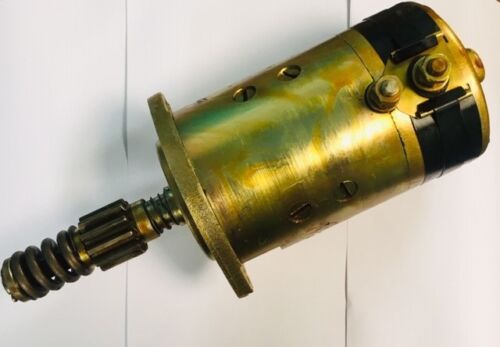Laurie Bonesetter
Member
- Posts
- 41
- Location
- Belfast
Ok... so if I change the solenoid to 12? Should work but might reduce the working life of starter and solenoid? Electrics give me a headache....

This needs a little bit of clarification.No life on a bench test.
This needs a little bit of clarification.
Do you mean no life i.e. sound at all? Or does the solenoid click but the motor doesn't drive the pinion?
There are contacts in the solenoid and brushes on the motor which might just need changing.
Have you got a quote from a starter/alternator rebuild specialist? They are usually quite a bit cheaper than a new unit.
As for running a 12v motor with 24 volts, I knew a chap who used to take a 24v lorry battery with him whenever he went to pick up a car that had been standing a long time. (This was a few years ago, in the days pre electronic ignition, OBD-whatever). He reckoned it didn't do it any harm just to use it to get the car to start!
Logically, if you apply 24 volts to a 12 volt motor, the extra wattage will maifest itself as bigger sparks at the contacts and the motor spinning faster and harder than normal. It might be OK for a while. You could possibly reduce the current to the motor by wiring a fu ck off big resistor in series with the motor, but I am very much an old skool mechanic when it comes to electrics. Others will probably jump in and correct me if I am wrong.
But according to this, unless your starter is a permanent magnet type, you should be ok in the short term, but it isn't a long term solution.
https://www.quora.com/Can-I-run-a-12-volt-starter-motor-with-a-24-volt-lead-acid-battery
Mine looks like this... Solenoid is on the bulkhead. ( petrol )

I took it to the local auto spark to let them see if it's fixable. The 12 volt version is a lot cheaper and readily available. If I stick a 12v starter and solenoid in what happens .. will it explode, melt or work?
Judging by his pic it is an inertia.SEarhc you tube then take it apart CAREFULLY. Don't try to getthe solenoid apart yet or take the starer staror or armature out. There's a very good chance you just need to get to the brushes and to make sure the sloenoind (I'm assuming its pre-engaged) moves freely. When you get the end cover off leave the wires connected. Clean all the connections and look for burning / melting around the brush holders. Clean the commutator. These things are realy tough and over engineered compared to modern ones so there's a good chance its fixable. I see there are inertia and pre-engaged listed but nothing under £250 so its worth a poke about.
One here on ebay:I'll find out tomorrow re price to fix.
Can anybody clarify what a surcharge is?
24 Volt Starter Motor (Petrol) Recon 250.00 Surcharge Applies on Return Of Old Unit......from Craddocks.
Welcome To LandyZone, the Land Rover Forums!
Here at LandyZone we have plenty of very knowledgable members so if you have any questions about your Land Rover or just want to connect with other Landy owners, you're in the right place.
Registering is free and easy just click here, we hope to see you on the forums soon!
